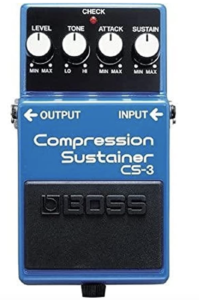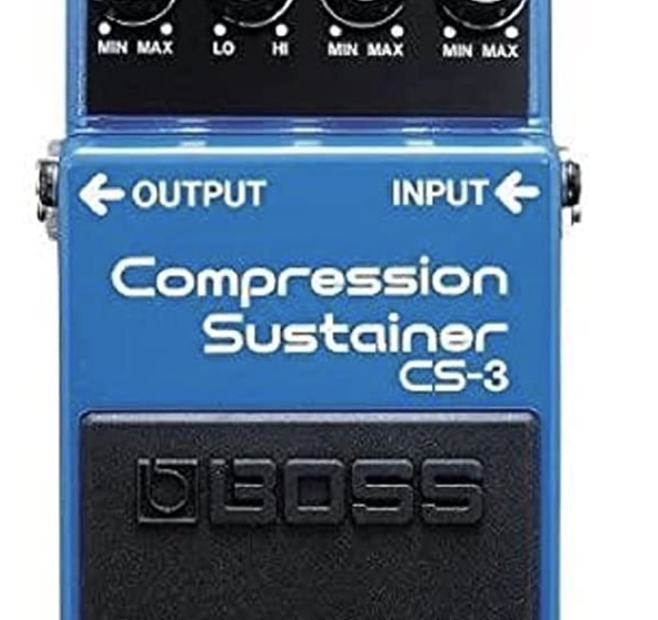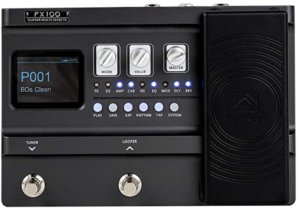 The BOSS CS-3 is a modern compressor pedal with all modern features you can expect to make your guitar sound even better.
The BOSS CS-3 is a modern compressor pedal with all modern features you can expect to make your guitar sound even better.
A compression pedal for guitar is a type of effect pedal used to control the dynamic range of a guitar signal. It reduces the volume of loud parts and increases the volume of quiet parts, resulting in a smoother and more balanced sound. This can help even out the volume differences between notes and chords, and can also add sustain to the guitar tone.
General Features
The CS-3 Compression Sustainer pedal offers smooth sustain without sacrificing sound quality. It achieves this effect by compressing louder signals. It is also capable of boosting lower signals, making them easier to hear.
Precise tonal shaping is possible with its onboard, which has controls that include:
- Level,
- Tone,
- Attack, and
- Sustain controls.
Additionally, its low-noise design ensures easy and silent operation. This pedal is ideal for guitarists and bassists seeking to enhance their sound.
Flamma FX100 Guitar Multi-effects Pedal
Nux Loop Core Pedal: The Looper To Rule All
Guitar Synthesizer: BOSS SY-1 Pedal
9 Best Vocal Effects Pedals for 2022
Mooer E7: Polyphonic Guitar Synth Effects Pedal Review
Using BOSS CS-3 For Dynamic Range
 Dynamic range refers to the difference in volume between the loudest and quietest parts of an audio signal. In the case of a guitar signal, this can refer to the difference between the loudest strummed chord and the quietest picked note.
Dynamic range refers to the difference in volume between the loudest and quietest parts of an audio signal. In the case of a guitar signal, this can refer to the difference between the loudest strummed chord and the quietest picked note.
A guitar’s dynamic range can vary dramatically, depending on factors such as the playing style, the type of guitar and pickups used. It also changes according to the signal processing method applied.
Compression pedals can be used to reduce the dynamic range of a guitar signal. In addition, this make its sound more consistent, allowing the player to shape the tone to their liking.
Improving Guitar Tone
Guitar tone refers to the unique sound that a guitar and its components produce. The components of sound include elements like the following:
- strings,
- pickups,
- amplifier(s),
- sound effects,
- pedals,
- and others.
 Many factors shape guitar tone, such as the wood used for the body and neck. Also, elements like the pickups installed, the string type and gauge can have influence. Additionally, it is also defined by the settings on the amplifier and effect pedals.
Many factors shape guitar tone, such as the wood used for the body and neck. Also, elements like the pickups installed, the string type and gauge can have influence. Additionally, it is also defined by the settings on the amplifier and effect pedals.
A guitarist’s playing style, including technique and touch, also significantly affect the tone. Guitar tone is crucial to a guitarist’s sound and distinguishes one player from another.
The BOSS CS-3 Adjustments
 Compression pedals typically have several adjustable parameters that allow the player to shape the effect to their liking. These may include:
Compression pedals typically have several adjustable parameters that allow the player to shape the effect to their liking. These may include:
- Threshold: This sets the level at which the compression effect starts to take place.
- Ratio: This sets the amount of compression applied to the signal. A higher ratio means that more compression is applied.
- Attack: This sets the time it takes for the compression effect to start after the threshold is exceeded. A faster attack time means that the compression effect will start sooner.
- Release: This sets the time it takes for the compression effect to end after the signal drops below the threshold. A longer release time means that the compression effect will last longer.
- Gain: This adjusts the overall volume of the compressed signal.
By adjusting these parameters, a player can fine-tune the compression effect to suit their playing style and the type of music they are performing.

